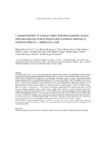Mostrar o rexistro simple do ítem
Compared decline of residual kidney function in patients treated with automated peritoneal dialysis and continuous ambulatory peritoneal dialysis: a multicenter study
| dc.contributor.author | Pérez-Fontán, Miguel | |
| dc.contributor.author | Remón Rodríguez, César | |
| dc.contributor.author | Borrás Sans, Mercé | |
| dc.contributor.author | Sánchez Álvarez, Emilio | |
| dc.contributor.author | da Cunha Naveira, Marta | |
| dc.contributor.author | Quirós Ganga, Pedro | |
| dc.contributor.author | López-Calviño, Beatriz | |
| dc.contributor.author | Rodríguez Suárez, Carmen | |
| dc.contributor.author | Rodríguez-Carmona, Ana | |
| dc.date.accessioned | 2019-02-07T09:14:48Z | |
| dc.date.available | 2019-02-07T09:14:48Z | |
| dc.date.issued | 2015-01-08 | |
| dc.identifier.citation | Pérez Fontán M, Remón Rodríguez C, Borrás Sans M, et al. Compared decline of residual kidney function in patients treated with automated peritoneal dialysis and continuous ambulatory peritoneal dialysis: a multicenter study. Nephron Clin Pract. 2014; 128(3-4): 352-360 | es_ES |
| dc.identifier.issn | 1660-2110 | |
| dc.identifier.uri | http://hdl.handle.net/2183/21688 | |
| dc.description.abstract | [Abstract] BACKGROUND: There is controversy concerning the compared rates of decline of residual kidney function (RKF) in patients treated with continuous ambulatory peritoneal dialysis (CAPD) and automated peritoneal dialysis (APD). OBJECTIVES AND METHOD: Following an observational, multicenter design, we studied 493 patients initiating peritoneal dialysis (PD) in four different Spanish units. We explored the effect of the PD modality on the rate of decline of RKF and the probability of anuria during follow-up. We applied logistic regression for intention-to-treat analyses, and linear mixed models to explore time-dependent variables, excluding those affected by indication bias. MAIN RESULTS: Patients started on APD were younger and less comorbid than those initiated on CAPD. Baseline RKF was similar in both groups (p = 0.50). Eighty-seven patients changed their PD modality during follow-up. The following variables predicted a faster decline of RKF: higher (rate of decline) or lower (anuria) baseline RKF, younger age, proteinuria, nonprimary PD, use of PD solutions rich in glucose degradation products, higher blood pressure, and suffering peritonitis or cardiovascular events during follow-up. Overall, APD was not associated with a fast decline of RKF, but stratified analysis disclosed that patients with lower baseline RKF had an increased risk for this outcome when treated with this technique (HR: 2.26, 95% CI: 1.09-4.82, p = 0.023). Moreover, the probability of anuria during follow-up was overtly higher in APD patients (HR: 3.22, 95% CI: 1.25-6.69, p = 0.002). CONCLUSIONS: Starting PD patients directly on APD is associated with a faster decline of RKF and a higher risk of developing anuria than doing so on CAPD. This detrimental effect is more marked in patients initiating PD with lower levels of RKF. | es_ES |
| dc.language.iso | eng | es_ES |
| dc.publisher | Karger | es_ES |
| dc.relation.uri | http://dx.doi.org/10.1159/000368933 | es_ES |
| dc.subject | Anuria | es_ES |
| dc.subject | Automated peritoneal dialysis | es_ES |
| dc.subject | Continuous ambulatory peritoneal dialysis | es_ES |
| dc.subject | Kidney function | es_ES |
| dc.subject | Proteinuria | es_ES |
| dc.title | Compared decline of residual kidney function in patients treated with automated peritoneal dialysis and continuous ambulatory peritoneal dialysis: a multicenter study | es_ES |
| dc.type | info:eu-repo/semantics/article | es_ES |
| dc.rights.access | info:eu-repo/semantics/openAccess | es_ES |
| UDC.journalTitle | Nephron Clinical Practice | es_ES |
| UDC.volume | 128 | es_ES |
| UDC.issue | 3-4 | es_ES |
| UDC.startPage | 352 | es_ES |
| UDC.endPage | 360 | es_ES |






